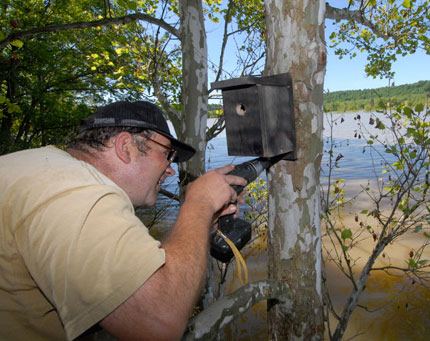Main Content
Article
Wildlife Management on Reservoirs

The mission of the wildlife management program is to professionally restore, create, manage and conserve habitat suitable for native game species that results in diverse outdoor recreational experiences for hunters and other users alike.
Eight state reservoir properties currently comprise 18 percent of the total acreage held by the Indiana Department of Natural Resources. These areas provide multiple consumptive and non-consumptive wildlife uses, directly and indirectly, with opportunities for hunting, fishing, bird watching, sport dog running/training, field trials, and shooting range use.
Though reservoir habitat management benefits such secondary uses as bird watching, mushroom hunting and other human foraging, hiking, biking, photography, and other activities, natural resource management is primarily directed toward maintaining a diversity of habitat which attracts game species. However, non-game management (American bald eagle, river otter, wading birds, etc.) is also a prominent component of management objectives and decisions on reservoir lands.
Habitat Management
Managing game and non-game wildlife on reservoirs is largely about maintaining the proper resources that different populations of wildlife need, such as food, water, shelter, and other special needs. These are all components of habitat. Wildlife managers spend a lot of time monitoring populations and manipulating habitat so that different populations have all the resources they need to thrive. For example, if a particular species is struggling in a specific management unit, it is important to identify the most limited resource required by that species and then manipulate the habitat to provide that resource in more abundance. Depending on the species, limited resources might include, soil nutrients, water, temperature, specific foods, forests of a certain age, and so on.
Much of Indiana’s wildlife species prefer different habitat arrangement as well. Wildlife managers also spend time ensuring that different habitat components are interspersed with each other across large areas, sometimes entire properties. The result is a diverse landscape of differing habitats.
Strong habitat management requires managers to use a handful of different tools and techniques. The most important of these is succession control, or manipulating how and where old fields mature into forests of different ages and structures. Other techniques include the use of prescribed fire and maintaining food plots and agricultural areas.
Hunting and Trapping
Many opportunities await sportsman and women at our reservoirs. Follow the links below to learn more about what’s available at each of our reservoirs.
- Brookville
- Cagles Mill (Lieber SRA)
- Cecil M. Harden (Raccoon SRA)
- Hardy
- Mississinewa
- Monroe
- Patoka
- Salamonie
Get a copy of the current DNR Hunting Guide to see hunting/trapping regulations.
Special Hunts and Activities
In addition to regularly available public hunting opportunities, most reservoirs conduct special draw hunts for specific species such as dove, pheasant, and waterfowl. Youth hunts and special hunting and fishing events for all ages are also available. Contact the property of interest or click below to apply for a special draw hunt.
Non-Horse Back Field Trials
Non-horse back field trialing with dogs is a popular way of spending time outdoors. The link below will help as you plan an event at one of our participating reservoirs.
Crop and Trap Leasing
Most reservoirs (excluding Lieber – Cagles Mill) regularly lease agricultural acreage to local farmers on four year terms. This provides supplemental habitat for wildlife and provides revenue for the wildlife program.
Trap leasing is also available at some reservoirs. These two-year leases help control certain species in key areas of the property. Contact the property of interest for more information on crop and trap leasing.
